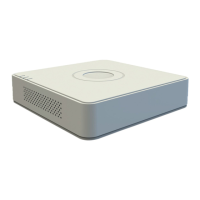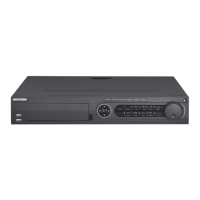Do you have a question about the HIKVISION DS-7316HUI-K4 and is the answer not in the manual?
| Product color | Black |
|---|---|
| USB connectivity | Yes |
| Channels quantity | 16 channels |
| Total storage capacity | 24000 GB |
| Maximum video resolution | 3840 x 2160 pixels |
| Video compression formats | H.264, H.264+, H.265, H.265+ |
| Analog signal format system | NTSC, PAL |
| Playback resolutions supported | 4K (3840 x 2160) / 30 Hz, 2K (2560 x 1440) / 60 Hz, 1920 x 1080 / 60 Hz, 1280 x 1024 / 60 Hz, 1280 x 720 / 60 Hz, 1024 x 768 / 60 Hz |
| Number of users | 128 user(s) |
| Ethernet interface type | Gigabit Ethernet |
| Ethernet LAN (RJ-45) ports | 2 |
| Supported network protocols | TCP / IP, PPPoE, DHCP, Hik-Connect, DNS, DDNS, NTP, SADP, NFS, iSCSI, UPnPTM, HTTPS, ONVIF, SNMP |
| RS-485 ports | 1 |
| USB 2.0 ports quantity | USB 2.0 ports have a data transmission speed of 480 Mbps, and are backwards compatible with USB 1.1 ports. You can connect all kinds of peripheral devices to them. |
| Power requirements | 100 - 240 VAC |
| Power consumption (typical) | 65 W |
| Operating temperature (T-T) | -10 - 55 °C |
| Operating relative humidity (H-H) | 10 - 90 % |
| HDD interface | Serial ATA |
| Maximum HDD capacity | 8000 GB |
| Number of HDDs supported | 4 |
| Depth | 390 mm |
|---|---|
| Width | 445 mm |
| Height | 70 mm |
| Weight | 5000 g |
Description of the buttons and indicators on the front panel of the DVR for model DS-73xxHUI-K4.
Instructions on how to operate the DVR using the included IR remote control, including troubleshooting.
Guide to using a standard 3-button USB mouse for navigation and control of the DVR.
Explanation of the soft keyboard layout and icons used for text input on the DVR.
Overview of the connectors and ports available on the rear panel of the DVR.
Procedures for safely starting and shutting down the DVR to ensure device longevity.
Steps to activate the DVR for the first time by setting an administrator password.
Guide on configuring and using an unlock pattern for device login.
Instructions for logging into and out of the DVR system.
Procedure for resetting the administrator password using a GUID file.
Steps to add and activate IP cameras for the DVR, including online and custom methods.
How to modify the network and password settings for connected IP cameras.
Setting up analog and IP signal input types and enabling long-distance transmission.
Enabling 5 MP long distance transmission for HUI series DVRs.
Overview of various functions available in Live View mode, such as single/multi-screen and recording.
Detailed description of mouse operations within the Live View interface.
Instructions on how to switch between main and auxiliary video outputs.
Explanation of the icons and functions available in the quick setting toolbar.
Configuring Channel-Zero Encoding to view multiple channels with reduced bandwidth.
Customizing Live View settings like output interface, dwell time, and audio.
Diagnosing video quality of analog channels manually and viewing results.
Procedure to set PTZ parameters before controlling PTZ cameras.
Guide to setting PTZ presets, patrols, and patterns for camera automation.
Steps to define preset locations for PTZ cameras to point to.
How to make the PTZ camera move to a specified preset position.
Setting up patrols to move the PTZ camera between key points with specified durations.
Instructions on how to activate a predefined patrol path for the PTZ camera.
Recording PTZ camera movements to create custom patterns.
Activating predefined patterns to move the PTZ camera along a specific path.
Enabling and defining the range for horizontal scanning of PTZ cameras.
Activating the linear scan function within a predefined scan range.
Configuring automatic park actions (scan, preset, patrol) after inactivity.
Accessing and using the PTZ control panel interface for camera movement.
Setting up encoding parameters like resolution, frame rate, and bitrate for recording.
Setting up schedules for automatic recording based on time or events.
Setting up motion detection areas, sensitivity, and response actions.
Setting up recording and capture triggered by alarm inputs.
Configuring recording and capture triggered by VCA events like face or intrusion detection.
Enabling manual recording and continuous capture, which overrides scheduled recording.
Setting up different recording plans for holidays.
Enabling redundant recording to save data on both primary and redundant HDDs.
Managing HDDs in groups for organized storage of recorded files.
Methods to protect recorded files by locking them or setting HDD to read-only.
Enabling or disabling H.264+/H.265+ compression for analog cameras.
Overview of playback functions, including instant playback and normal search.
Playing back recorded video files of a specific channel in Live View mode.
Searching and playing back recorded files by channel or time.
Description of the playback interface and toolbar controls.
Searching and playing back files based on event types like motion or alarm.
Searching and playing back files using video tags.
Using smart playback to speed through less relevant video and highlight events.
Playing back record files associated with channels after searching system logs.
Playing back video files in multiple sub-periods simultaneously.
Looking up and playing back files stored on external devices.
Additional playback features like frame-by-frame and digital zoom.
Procedures for backing up recorded files and data.
Backing up files found via normal video or picture search.
Steps for backing up files using USB flash drives and HDDs.
Backing up event-related record files using USB devices.
Exporting video clips directly from playback mode.
Management of USB flash drives, USB HDDs, and eSATA HDDs used for backup.
Configuring motion detection areas, sensitivity, and alarm response actions.
Setting up handling methods for external sensor alarms.
Diagnosing video quality manually and all-day, setting thresholds and linkage actions.
Configuring response methods for various system exceptions like HDD full or network disconnect.
Setting up POS functions, including privacy information filtering and protocols.
Assigning POS machines to specific camera channels for overlay.
Setting POS alarm parameters to trigger actions like recording or notifications.
Configuring face detection rules, sensitivity, and linkage actions.
Setting up vehicle detection for traffic monitoring and license plate capture.
Detecting objects crossing a virtual line and configuring alarm actions.
Detecting objects entering or loitering in a predefined virtual region.
Detecting objects entering a predefined virtual region.
Detecting objects exiting a predefined virtual region.
Detecting objects loitering in a region for a specified duration.
Triggering alarms when people gather in a predefined virtual region.
Detecting objects moving quickly within a predefined virtual region.
Detecting illegal parking in specified areas.
Detecting unattended objects left in a predefined region.
Detecting objects removed from a predefined region.
Detecting abnormal sounds like sudden increase/decrease in sound intensity.
Detecting image blur caused by lens defocus.
Detecting changes in the surveillance scene environment.
Triggering alarms based on Passive Infrared (PIR) detection of movement.
Analyzing suspicious behavior based on VCA detection results.
Searching and viewing captured vehicle plate pictures and related information.
Calculating and reporting the number of people entering or leaving an area.
Analyzing customer visit times and dwell times using color-coded heat maps.
Setting up general network parameters like IP address, gateway, and DNS.
Configuring advanced network features like PPPoE, Hik-Connect, and DDNS.
Enabling and configuring PPPoE connection for network access.
Setting up Hik-Connect for mobile and remote access to the DVR.
Configuring Dynamic DNS to access the DVR using a domain name.
Setting up an NTP server to ensure accurate system date and time.
Enabling and configuring UPnP™ for seamless network device discovery and connection.
Configuring additional network settings like alarm host and multicast IP.
Setting up the HTTPS port for secure Web access to the DVR.
Setting up email notifications for alarms or motion events.
Monitoring real-time network traffic information like sending/receiving rates.
Performing network tests to check connectivity status, delay, and packet loss.
Testing network delay and packet loss between the DVR and a destination address.
Exporting captured network data packets to a backup device.
Verifying the current network status of the DVR.
Viewing real-time network statistics and bandwidth information.
Setting up RAID arrays for data redundancy and storage.
Enabling the RAID function before creating a disk array.
Quickly creating a disk array using the one-touch configuration method.
Manually creating RAID arrays (0, 1, 5, 6, 10) by selecting disks.
Understanding array working statuses and the process of rebuilding degraded arrays.
Ensuring data security by automatically rebuilding arrays with hot spare disks.
Manually rebuilding arrays when the virtual disk is in a degraded status.
Procedure for deleting a RAID array and its associated data.
Steps to initialize a newly installed hard disk drive before use.
Adding and managing NAS or IP SAN disks as network HDDs.
Organizing multiple HDDs into groups for channel-specific recording.
Setting HDD properties to redundancy, read-only, or read/write (R/W).
Allocating storage quotas for individual cameras.
Setting up cloud storage for uploading and downloading recorded files.
Cloning data from one HDD to an eSATA disk.
Monitoring the status of installed HDDs for potential failures.
Viewing S.M.A.R.T. data for HDD reliability monitoring.
Detecting bad sectors on the HDD to check its status.
Setting up alarms for HDD errors like uninitialized or abnormal status.
Configuring On-Screen Display settings like date, time, and camera name.
Setting up privacy mask zones to obscure specific areas of the video feed.
Adjusting image parameters such as brightness, contrast, and sharpness.
Setting camera-specific parameters like signal switch, defog, and day/night sensitivity.
Accessing and viewing device information, camera details, and network status.
Viewing and exporting system operation, alarm, and exception log files.
Saving and loading IP camera configuration data via Excel files.
Exporting DVR configuration for backup or importing to multiple devices.
Updating the DVR system firmware using local backup or FTP.
Upgrading firmware for multiple connected analog cameras simultaneously.
Resetting DVR parameters to factory defaults or specific states.
Setting general device options like language, output resolution, and time zone.
Configuring the RS-232 serial port for parameter configuration or transparent channel.
Setting up Daylight Saving Time (DST) adjustment.
Adjusting additional settings like device name, auto logout, and VCA modes.
Adding, deleting, and editing user accounts with different permission levels.
Creating new user accounts with specific names, passwords, and permissions.
Removing existing user accounts from the DVR.
Modifying parameters for existing user accounts.
Detailed technical specifications for the DVR models.
Technical specifications for the DS-73xxHUI-K4 series DVR.
Technical specifications for the DS-90xxHUI-K8 series DVR.
Technical specifications for the DS-73xxHQI-K4 series DVR.
Definitions of technical terms and acronyms used in the manual.
Solutions for common issues encountered with the DVR.
List of Hikvision IP cameras compatible with the DVR.
List of third-party IP cameras compatible with the DVR.











